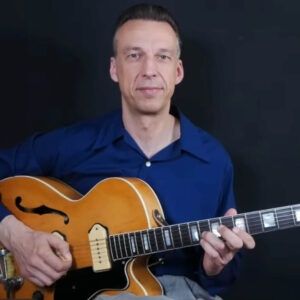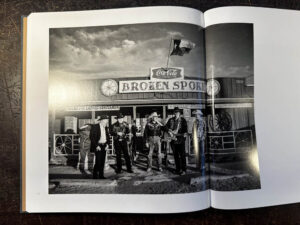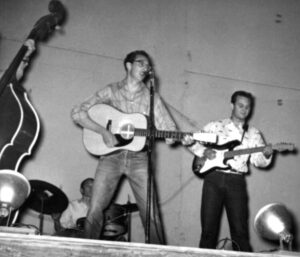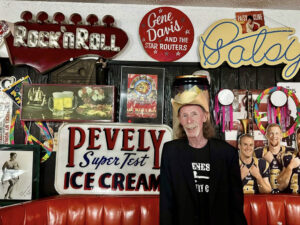Liner notes for Blues Theme, Bear Family Records
Sundazed Music, reissued in 2005
Some of the most interesting records in the history of rock and roll were the ones that straddled the fence—with one foot in a preceding era and one foot in a new, uncharted direction. Think about Bill Haley and the Comets making “rock and roll” records in 1953 with a steel guitar and accordion, or for that matter the Beatles’ embryonic Liverpool and Hamburg days playing hits from the 1950s with a faster, louder beat that ushered in a new era.
In much the same way, Davie Allan and the Arrows’ classic 1967 LP Blues Theme straddled the fence between the earlier surf and twang days of the Ventures on one side and the long-haired biker grunge rock of the late-1960s flower-power generation on the other. Frozen in a classic moment in time, when hippies were on the front page of the newspapers but the general public still wore buzz cuts and bouffants, the fuzz-drenched instrumental rock of Davie Allan and the Arrows must have seemed as dangerous as a gang of outlaw bikers coming over the hill.
“Blues Theme” was a monster hit in the spring of 1967, reaching the Top 5 all around the West Coast and #37 on Billboard. The song had been cut as a quickie for the movie The Wild Angels (Peter Fonda’s biker flick that came shortly before Easy Rider) but soon found a life of its own as a hit single and title track for Davie’s second long-player.
The history of Davie Allan and his producer/cohort Mike Curb has been well documented in the first installment of this reissue series by Stephen McParland, but we’ll touch on the important facts again here. Davie and Mike Curb both attended Grant High School in Van Nuys, a suburb of Los Angeles in the San Fernando Valley. They met in the school choir but discovered that they both had a love for rock and roll; Davie was a wunderkind on the electric guitar and Mike Curb was a piano player and entrepreneur of the highest order. Soon the two began collaborating, which led to a string of great but obscure surf instrumentals released under such names as the Heyburners, Mike Curb and the Curbstones, the Zanies, and many others.
Eventually Curb released “War Path” / “Beyond the Blue” under Davie Allan’s name on the Cude label, but it wasn’t until “Apache ‘65” b/w “Blue Guitar” was released in late 1964 on Curb’s Sidewalk label that the famous nom de plume “The Arrows Featuring Davie Allan” appeared. Originally the band name was derived as a way to capitalize on the Indian motif of “Apache ‘65,” but the name stuck and would serve Davie for the rest of his career.
The next few years would see Davie Allan and Mike Curb collaborating on a staggering number of records, film soundtracks, and side projects. There were so many sessions (and multiple uses for the same backing tracks, in many cases) that discographers are just now beginning to fully unravel the extent of this highly productive period of creativity.
Davie’s first self-credited album (released as The Arrows Featuring Davie Allan) was Apache ‘65, released on the Tower label in 1965. It was a great collection of clean-sounding surf guitar instrumentals, concentrating heavily on the Indian theme. Some of its tracks (“Tee Pee,” “Tomahawk,” “Indian Giver”) wouldn’t pass the PC-censors today.
What followed in the next few years was a near-complete transformation of Davie’s sound – and, for that matter, the music business in general. The Beatles hit the American record market like a hurricane, wiping out all surf instrumentals in their path. At the movie theaters, the Beach Party series starring Frankie and Annette was no longer in fashion, and a new breed of films emerged that documented (and exploited) the new juvenile-delinquent-hippie-biker-drug scene on the West Coast. Mike Curb and his crew at Sidewalk Productions were there with their fingers on the pulse of this emerging genre of films, and over the next five years they would produce over twenty soundtrack albums with Davie’s musical involvement.
There were in fact eight soundtrack albums issued before Davie’s second self-titled LP, Blues Theme, was issued in 1967 on Tower Records. Listening to the soundtrack albums, one can hear Davie and his crew transform from a squeaky-clean surf group into an angry bunch of outlaw malcontents over the course of only two years!
In retrospect, Davie Allan and the Arrows were the only group besides the Ventures to survive the British Invasion and the Hippie Movement and continue producing guitar instrumental music through the late 1960s. Both groups had to adapt to the changing times, and interestingly enough both groups learned to use and love a new electronic gizmo called a fuzztone.
Distorted guitar was nothing new, dating back to the ‘40s when blues and western swing guitar players had to turn their small amps up all the way to compete with horn sections and drummers. Link Wray is generally credited with being the first to intentionally make a fuzz effect by punching holes in his guitar amp’s speakers, creating the overdriven effect heard on his landmark instrumental hit “Rumble.” Similarly, Paul Burlison of Johnny Burnette’s Rock ‘n’ Roll Trio had a wildly distorted sound on the influential rockabilly obscurity “Train Kept A-Rollin’,” which was caused by an amp malfunctioning from a loose tube.
However, the first fuzztone as we know it today was created accidentally by Nashville engineer Glen Snoddy during a 1961 Marty Robbins session. As Robbins was cutting “Don’t Worry,” one of the preamps on the recording mixing console began to malfunction and create a unique, fuzzy, distorted tone. Guitarist Grady Martin saw its commercial potential and used the effect on the record, which became a hit. After that artists clamored for the special effect for use on their records until Snoddy built a stand-alone solid-state battery-powered pedal unit and marketed it to Gibson. This unit became the first commercially available fuzz, known as the Maestro Fuzz-Tone.
Soon “fuzz” was the order of the day, with companies like Vox and Fender making their own version of the effect. Perhaps the wildest fuzz of the era, however, was the infamous Mosrite FuzzRite pedal, which created a very compressed, psychedelic-sounding fuzz that was perfect for the new “freakout” music. Both the Ventures (who co-owned Mosrite and had a hugely successful line of Mosrite Ventures model guitars) and Davie Allan used the FuzzRite pedal, and that’s the sound you hear all over these recordings.
Davie was still using his surf equipment, namely his Fender Jazzmaster guitar and Fender Concert amp, when he borrowed a Mosrite FuzzRite from a friend for “Blues Theme.” After the wild new sound was committed to tape, there was no turning back, and even today Davie Allan carries the title King of the Fuzz Guitar. It’s a totally unique sound, one that is instantly recognizable as Davie Allan and nobody else. (It should be noted here that even though Davie and the Arrows are pictured on the cover holding Mosrites—including Davie’s famous doubleneck—the entire Blues Theme album was recorded with the Fender Jazzmaster and the FuzzRite pedal!!)
The song “Blues Theme” was recorded quickly, in mono only, to meet a production deadline for the movie The Wild Angels, where it was used in Peter Fonda’s introductory scene. In fact, the motorcycle sound effects spliced onto the record are actually from Peter Fonda’s Harley Davidson! Soon the hit potential of the song was realized, and it was released as a 45, and then as the title track for Davie’s second album. Since it was recorded so quickly, however, a stereo version never existed.
The most important thing to remember when approaching the Blues Theme album (or any of Davie’s other records from the ‘60s) is that none of them were planned as albums. They were made up of many sessions, some released as 45-rpm singles (the prevailing format of the day) and some as soundtrack recordings. To make things even more confusing, some tracks were used on soundtrack albums, then new guitar solos (and in some cases, vocals) were overdubbed to create “new” songs. In that light, the Blues Theme album is quite an interesting hodgepodge.
“Blues Theme” was released first as a Tower single, and then subsequently re-released on the album of the same name. “Theme from the Wild Angels” was also released as a single, but not before being used on the Wild Angels soundtrack LP. “King Fuzz” was an instrumental remake of a Harley Hatcher vocal originally called “The Twirl” (and subsequently reused as “Mario’s World” on the Albert Peckingpaw’s Revenge soundtrack LP). “Theme from the Unknown” was released several times previously under different names (“U.F.O.,” “The Dark Alley”) before making it to the Blues Theme LP under its original title. “Fuzz Theme” was retitled “The Young World” for the Teenage Rebellion soundtrack LP, then released under its original title on the Blues Theme LP. “Action on the Street” was originally called “Make Love Not War” on the Teenage Rebellion soundtrack LP, then overdubbed with a second solo and renamed for the Blues Theme LP. “William Tell ‘67” was recorded in 1965 and originally intended for the Apache ‘65 album, but it lay in the can for two years before being included on Blues Theme. The remainder of the tracks, “Ghost Riders in the Sky,” “Theme from Thunderball,” and “Sorry ‘bout That” (the latter written around Don Adams’s catchphrase on the Get Smart television show) were miscellaneous songs that had not been used before. Confused yet? If not, then please note that “Blues Theme” was released (misspelled) as “Blue’s Theme” on the 45 credits, but listed as “Blues Theme” on the LP. Got it now? If not, don’t worry… The Davie Allan, Mike Curb, and Harley Hatcher discography is a twisted tale that confuses even seasoned researchers of the genre.
The musicians that appeared on the Blues Theme album alongside Davie were Drew Bennett and Larry Brown, with Jared Hendler on keyboards. Wayne “Mickey Mouse” Allwine and Don Manning joined the group soon after when Larry Brown quit playing to concentrate on recording and producing.
One last interesting aspect of the sound and character of the Blues Theme album concerns the studio and recording engineer. All of the Davie Allan recordings were done at American Recording Studios with a young Richie Podolor behind the glass. Podolor was a hotshot producer and engineer who had started making rockabilly records in the late 1950s (under the name Dickie Podolor), then began recording such landmark hits as “Let There Be Drums” by Sandy Nelson. Under another assumed name (Ritchie Allen), Podolor released several dozen of the best surf instrumentals of the day on Imperial Records before finally giving up as an artist and concentrating on running his recording studio. As an engineer and producer he is responsible for many legendary recordings by the Standells, the Chocolate Watch Band, Steppenwolf, Iron Butterfly, Alice Cooper, Three Dog Night, and the heavy metal band Alcatrazz (yikes!)!
In short, everything that Podolor touched had a distinctive sound to it. With one of the first Ampex four-track machines in Los Angeles, he had overdubbing capabilities in the mid-1960s that were years out of reach for most other studios. His famous comment was: “Give me a Neumann U47 [microphone] and an Electro-Voice 666 [microphone] and I’ll go make a hit!” Given his track record, it would be hard to deny that statement!
Listen to the Blues Theme album and you’ll hear the transformation of instrumental music from one era to the next. From the pure Nokie Edwards-styled twangy guitar picking of “Theme from the Unknown” and “Ghost Riders in the Sky” to the far-out psychedelic sounds of “Action on the Street” and that career-defining track “Blues Theme,” Davie Allan took the instrumental surf-guitar genre and carved his own niche. That much can never be denied him. Viva la FUZZ!
(With thanks to Davie Allan and Garrett Immel)





